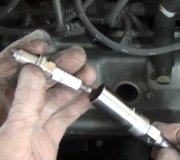I scan my car by using ELM 327 blue tooth device andfound the data which I will describe below
ECT -;203 F
IAT -;122 F
Throttle position -;12.15% [steady in idle]
maf air flow rate -;2.25, 2.79 g/s [variable]
engine rpm -; 6.68, 7.20 [variable]
calculated engine load value -; 18.82, 20.39% [variable]
timing advance -; 6.5, 11.5 [235-278 m/s]variable
bank 1 sensor 1 v -; 0.02, 0.89 [207 to 325 m/s]variable
bank 1, sensor 1 % -; -3.09 to -6.19
fuel system status -; closed loop using o2 sensor for fuel mix
short term fuel trim -; -2.89 to -7.02 % [235 - 278 m/s] variable for idle speed
long term fuel trim -; -20.3% [235-278 m/s] steady for idle speed
moniter dtc status. -; Error MIL:off spark ignition
kindly go through it. Which part is faulty. How to fix
thank you
SPONSORED LINKS
Sunday, January 11th, 2015 AT 1:40 AM




